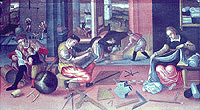
The Measurers:
a Flemish Image of Mathematics in the Sixteenth Century
Catalogue
The Mathematicians: catalogue nos 1 to 12
The Measurers: catalogue nos 13 to 39
The Collectors: catalogue nos 40 to 47
The Collectors
40 41 42 43 44 45 46 47
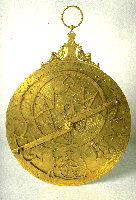
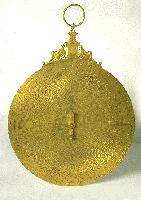
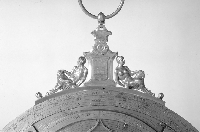
40. Astrolabe
Signed: Regnerus Arsenius Nepos Gemmę Frisij fecit Louanij anno 1565
Several features of this instrument are typical of Arsenius astrolabes - the figures supporting the
suspension piece, the italic script introduced by Mercator, but most distinctive of all is the
characteristic strapwork design used for the rete. In this case the rete has 36 stars. One latitude
plate survives and is engraved on either side for latitudes 45 and 51 degrees. Beneath the plates,
the mater carries a nautical square - 'Quadratum Nauticum' - for navigational calculations, such
as is illustrated and ascribed to Gemma in his version of Apian's Cosmographia. Instead
of the customary scales on the reverse, such as the shadow square and an equal-hour diagram,
this instrument has a beautifully executed example of Gemma's design of universal astrolabe, his
'astrolabum catholicum'.
Diameter: 289 mm
Roussel Collection
Lewis Evans Collection 2047
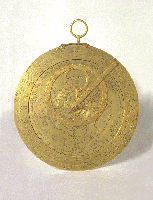
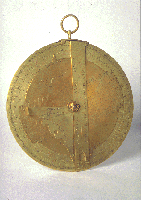
41. Astrolabe
Signed: Ęgidius cuiniet antuerpianus facieb. Ao 1560
This instrument relates closely to Gemma's editions of the Cosmographia of Apian. There
is a single plate, engraved on one side with a tablet of horizons, which links the time of the sun's
rising or setting to the latitude, and on the other with a geographical planisphere, centred on the
pole and extending to the Tropic of Capricorn. This planisphere uses the same projection as the
customary rete, but is a map of the earth rather than the heavens. It can be adjusted about the
centre, while above rotates a ring representing the ecliptic, engraved with the signs and degrees
of the zodiac. Eight star positions are marked by pointers within the ecliptic. An index arm, also
pivoted at the centre, has a latitude scale. The motion of the ecliptic ring thus represents the daily
paths of the sun throughout the year, the sun's position in the ecliptic for any date being given
by a zodiacal calendar on the mater. The index arm and scale of hours on the mater can be used
to find local times. The reverse side has a type of sundial based on the organum Ptolemei
projection, as described in the Cosmographia; in addition to the time, it gives the times
of sunrise and sunset and the duration of twilight.
Paper versions of both these instruments are, for example, in the 1584 Antwerp edition of the
Cosmographia (catalogue no. 2); the geographical planisphere in its paper form even has
a tablet of horizons beneath the planisphere.
Egidius Coignet was the father of Michael.
Diameter: 215 mm
Lewis Evans Collection 2027
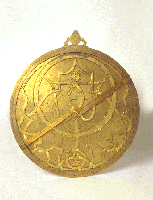
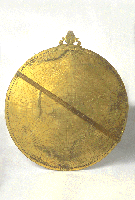
42. Astrolabe
Signed: Thomas II 1559 [i.e. Thomas Gemini]
The similarity in style between this astrolabe, made in London for Queen Elizabeth I, and those
from the Arsenius workshop in Louvain is particularly clear from the design of the rete, which
marks the positions of 23 stars. Like the Arsenius astrolabe (catalogue no. 40) the inside of the
mater has a nautical square and the back has Gemma's design of universal astrolabe. The single
surviving plate has a tablet of horizons on one side and on the other scales generally found on
the back of an astrolabe: a zodiacal calendar scale, a shadow square and a conversion diagram
for equal/unequal hours.
One side of the suspension piece carries the arms of Elizabeth I and the initials 'E R', and the
other is inscribed: 'Elizabeth Dei Gratia Anglię Francię & Hibernię Regina'. A further
inscription on the plate indicates that the astrolabe was given to the University by Nicholas
Greaves in 1659 for the use of the Savilian Professors. It had been the property of Nicholas's
brother John Greaves, Savilian Professor of Astronomy, who had taken it on an expedition to the
Levant in 1637-40.
Diameter: 355 mm
Provenance: Elizabeth I; John Greaves, Nicholas Greaves; University of Oxford, collection of
the Savilian Professors; University Observatory, Oxford.
Accession no. 36-6
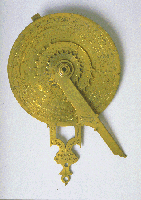
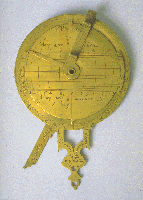
43. Nocturnal and sundial
Signed: Michael Coignet fe
Dated: 1598
The nocturnal side has a zodiacal calendar and date scale used to set the scale of hours (divided
to 15 minutes) on a volvelle plate with an index arm. For finding the time at night, with the
volvelle plate set to the date, the instrument is held vertically so that the pole star is viewed
through the central hole and the long index arm turned to coincide with the 'pointer' stars of the
Little Bear. Its position on the time scale then gives the time, which can be ascertained by
feeling, since the hour teeth (at 4 to 12 to 8) can be counted from the pointer at 12. The hour plate
also has a scale for Easter: 'Epacte Anno. 98' and there is an inner 24-hour volvelle plate. The
other side has the organum Ptolemei form of sundial - the same type as that on the
geographical astrolabe by Egidius Coignet (catalogue no. 41) and as described in Gemma's
editions of Apian's Cosmographia.
Diameter: 108 mm
Lewis Evans Collection G. 78
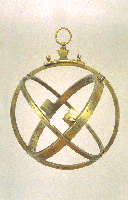 44. Astronomical rings
44. Astronomical rings
Signed: Nepos Gemmę Frisij Louanij fecit 1567
An example of the portable equatorial instrument designed by Gemma Frisius and made by his
nephew Gualterus Arsenius, signed not in his own name but as the nephew of the famous
mathematician. The signature is on the meridian ring, which is marked 'MERIDIANVS' and
'Meridianus' and has one quadrant engraved with a latitude scale divided to single degrees. This
is for setting the position of the suspension shackle and ring: the graduated section of the
meridian ring is pierced by a series of threaded holes and a brass plate on which the shackle is
mounted has a longitudinal slot so that it can be fixed by two screws at any position on the
latitude scale. The other two rings are pivoted on the meridian ring. One, at zero degrees and
marked 'Ęquator', folds out to stop at right angles to the meridian ring; the other, innermost ring
pivots freely about an axis set at 90 degrees. This ring - the declination ring - has a circular band
of brass moving friction-tight on its inner surface and to this band are attached a pair of
diametrically-opposed vanes with pinhole sights and pointers. When the instrument is adjusted
for the local latitude and suspended in the meridian with the upper pivot of the declination ring
towards the north, its axis points to the celestial pole (the upper pivot is marked 'Polus Arcticus',
the lower 'Polus Antarcticus') and the equatorial ring lies parallel to the equator. One side of the
declination ring is half divided 90 to 0 to 90 degrees and has a solar declination scale with zodiac
symbols on either side of the equator; the other side of the ring has an hour scale divided to 4
minutes, while the rim is marked for the declinations of named stars. The inner band carries a
zodiac scale with the positions of named stars marked in the zodiac (the engraving style on the
band is different from that on the body of the instrument). The equatorial ring is half graduated
on both sides with an hour scale divided to 4 minutes and has the signs of the zodiac on the rim,
while a quadrant on one side carries shadow square scales marked 'VMBRA RECTA' and
'VMBRA VERSA' used for surveying (fig. 19).
Diameter: 111 mm
Michel Collection; Billmeir Collection
Accession no. 57-84/24
45. Les principles d'astronomie et cosmographie: avec l'usage du globe. Le tout cõposé par
Gemma Frizon ... Plus, est adiousté l'usage de l'anneau Astronomic, par ledict Gemma
Frizon
Author: Gemma Frisius
Printed at Paris, in 1556
 46. Astronomical rings
46. Astronomical rings
Signed: ALBERTO . IMPERATORIS . FILIO . IMP : FRATRI * ISABELLĘ . PHILIPPI .
REGIS . FILIĘ . PHIL : REGIS . SORORI . ĘTERNVM . REGERE . IA . D . SVCCA.
Dated: 1600
As the inscription records, the instrument was presented to Albert, Archduke of Austria
(1559-1621), to whom the manuscript tract by Michael Coignet on the pantometric rules was
dedicated (see figs 7 & 8). Albert was son of Emperor Maximilian II and the Infanta Isabella
Clara Eugenia, daughter of Philip II of Spain. De Succa was an instrument maker in
Antwerp.
Tycho wrote in his Astronomiae instauratae mechanica of 1598 that, as an astronomical
instrument, Gemma's rings was no more than a toy, but he conceded that it did make a useful
sundial. Here the design has shed any pretensions to position measurement and has indeed
become a dial. The declination ring has only a scale of dates, equivalent to a solar declination
scale, and the scale portion of the ring is pierced by a slot in which is moved a decorated cursor
with a hole for the sun's rays; on the opposite side of the ring, at the point where the solar
declination angles are subtended, there is a target for the light admitted by the hole.
Correspondingly, the equatorial scale has a scale of hours, subdivided to 4 minutes. With the
latitude and solar declination adjustments properly made, the declination ring has to be turned
so that the spot hits the target, the instrument being suspended freely, and this is possible only
when the meridian ring is in the meridian. An index line, 'LINEA HORARIA', on the back of the
declination ring then indicates the time on the equatorial ring.
Diameter: 158 mm
Mercator and McVitty Collections; Billmeir Collection Accession no. 57-84/180
47. Armillary Sphere
16th-20th centuries?
The exhibition ends with a puzzling and ambiguous instrument which links the collecting
activities of the 16th and 20th centuries. Its current display label suggests that it might be
Flemish, but it awaits thorough examination and has yet to be fully understood. The upper part
of the instrument is a sixteenth century armillary sphere, but a very complex one. In addition to
the usual circles of the celestial sphere, adjustable for latitude and rotatable on a polar axis, there
are sixteen star pointers, an ecliptic axis of the type described in Ptolemy's Almagest and
what seems to be an adjustment for trepidation - a supposed oscillatory motion of the equinoxes.
This is very much a collector's item of the sixteenth century: its use may have extended to
teaching or demonstration, but it was not a practical mathematical instrument. The lower part has
a bronze figure of a kneeling man in a loincloth - perhaps meant to be Atlas - supporting the
world on his head and supported himself by a modern turned brass stand in two tiers,
incorporating a magnetic compass and three feet ornamented with satyrs. If the upper part, in its
geometrical complexity, represents the ambitions of a wealthy patron to associate himself with
the most sophisticated of the mathematical sciences, the lower was designed to appeal to much
later aesthetic expectations.
Height: 450 mm
Billmeir Collection
Accession no. 57-84/23a
The Mathematicians: catalogue nos 1 to 12
The Measurers: catalogue nos 13 to 39
Contents
(c) Museum of the History of Science, Broad Street, Oxford, England.










 44. Astronomical rings
44. Astronomical rings 46. Astronomical rings
46. Astronomical rings